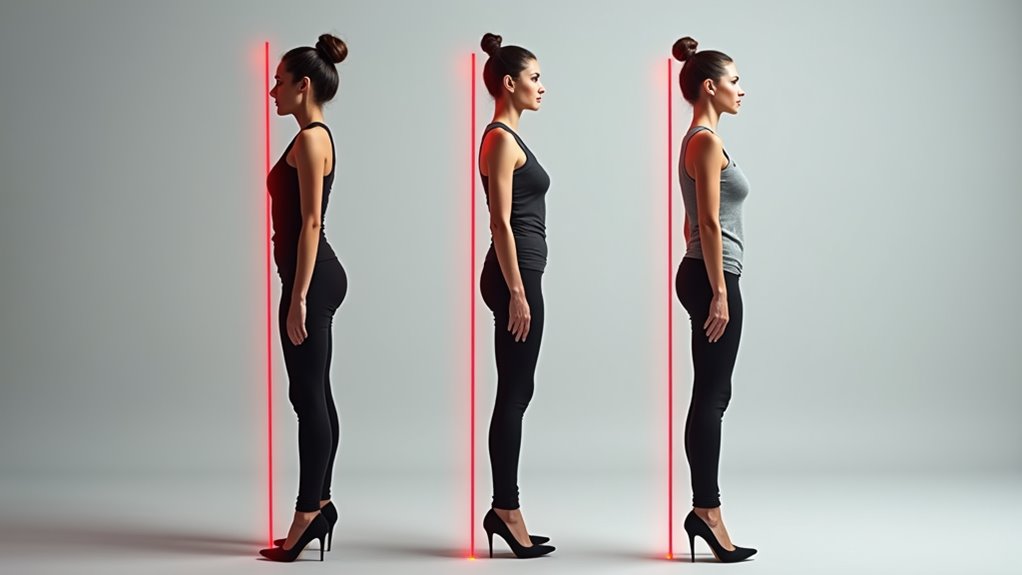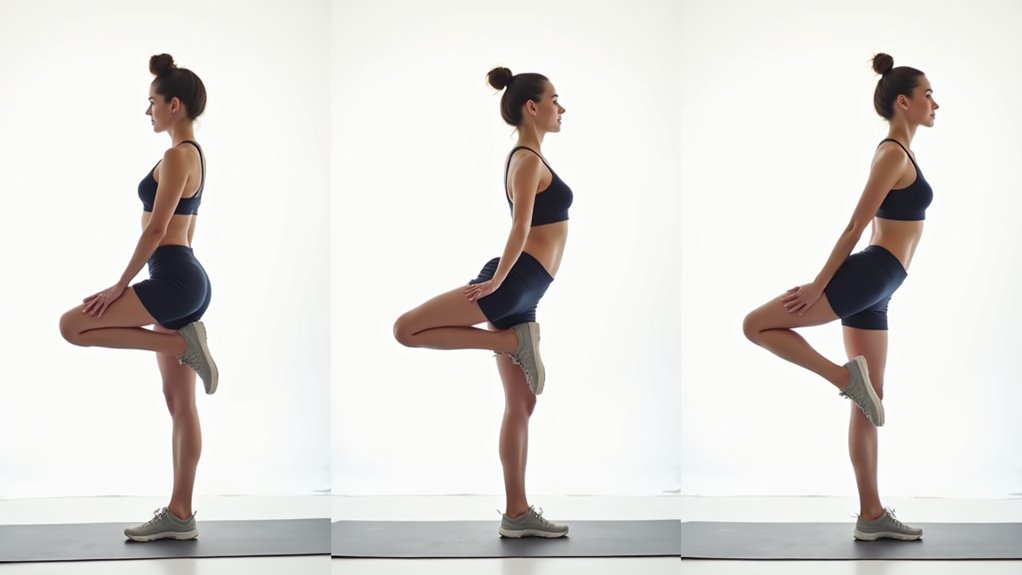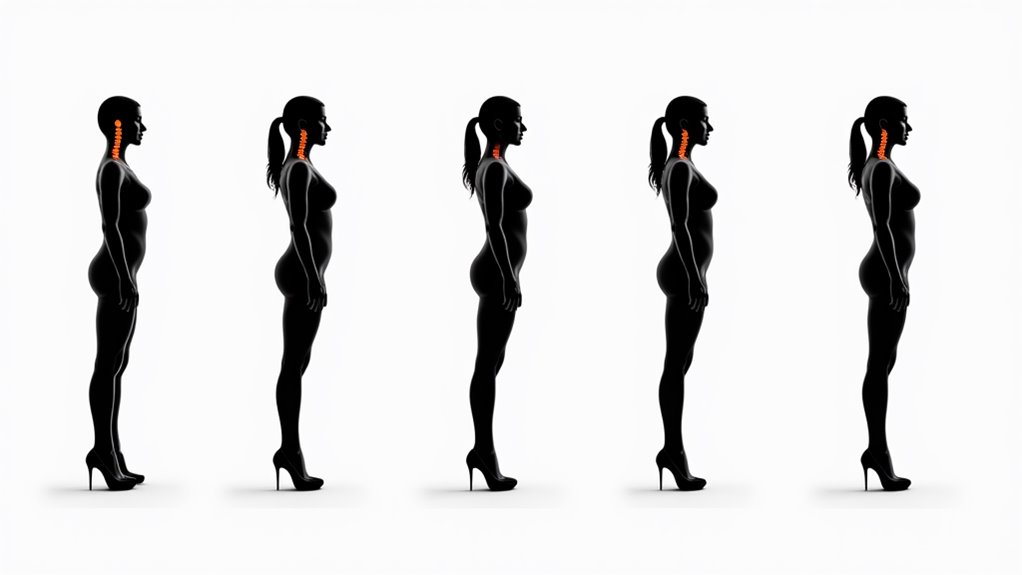There may be products. Products are independently selected by our editors. We may earn an affiliate commission from the links with no charge to you, example: as Amazon Affiliate.
When you’re navigating different heel heights throughout your day, you’ll quickly discover that each elevation demands its own postural adjustments. While a one-inch heel allows for near-natural movement, stepping into three-inch stilettos completely transforms your body’s alignment from your ankles to your spine. You might’ve noticed how some people seem to effortlessly glide in any heel height while others struggle to maintain their balance. The secret lies in understanding how your body needs to adapt and respond to these varying elevations—and it’s more than just standing up straight.
Key Takeaways
- Engage core muscles continuously to support spine alignment and maintain proper posture regardless of heel height.
- Distribute body weight evenly across the entire foot while keeping knees aligned with toes.
- Adjust shoulders and head position backward to compensate for the body’s natural forward shift in heels.
- Land on the balls of your feet while walking to minimize impact and maintain better control.
- Practice smaller heel-to-toe steps and keep your ribcage centered to optimize balance and stability.
The Impact of Heel Height

When you wear heels, their height significantly impacts your body’s alignment and balance. As you increase heel height, you’ll notice your head and shoulders shift backward while your body makes compensatory adjustments.
Your ribcage tends to shift left, and your hips and knees adapt differently based on the heel height. Lower heels cause your hips to move forward and knees to shift back, while higher heels create opposite movements.
Your stability also changes dramatically – as heel height increases, you’ll experience more balance disturbances, especially in side-to-side movements. If you’re experienced with high heels, you’ll likely have better balance control than novice wearers.
However, be aware that any heel height affects your posture and can increase muscle activity in your back to maintain alignment. For optimal comfort and support throughout the day, consider investing in comfort style heels that are specifically designed to distribute weight evenly.
Choosing the Right Footwear
Three crucial factors determine the right footwear for maintaining proper posture: your foot type, daily activities, and specific support needs.
Start by understanding your arch type – if you have flat feet, you’ll need strong arch support and stability features, while high arches require extra cushioning for shock absorption.
Consider your primary activities when selecting shoes. If you’re running, opt for lightweight options with good cushioning. For hiking, choose sturdy shoes with excellent traction. For daily wear, ensure your shoes have proper arch support and a firm heel counter.
Don’t forget to prioritize comfort over style. Make sure there’s adequate room in the toe box, and the shoes provide balanced weight distribution.
Visit a professional shoe store for accurate measurements, as proper fit is essential for maintaining alignment.
For elevated occasions, look for comfort-focused heels that provide stability while maintaining elegance.
Standing Tall in High Heels

You’ll find stability in high heels by distributing your weight evenly across your entire foot, rather than concentrating pressure on the balls of your feet.
Keep your core muscles engaged throughout the day to support your spine and maintain proper alignment while standing or walking.
Your knees should remain in line with your toes, avoiding inward collapse, to ensure optimal balance and prevent strain on your joints.
Consider investing in comfort pumps that provide adequate cushioning and arch support for extended wear.
Balance Your Weight Distribution
Mastering proper weight distribution is essential for comfortable heel-wearing and preventing long-term foot problems. When you’re wearing high heels, your weight naturally shifts forward, increasing pressure on the balls of your feet – up to 75% more in 3-inch heels.
To maintain better balance, stand with your feet shoulder-width apart and distribute your weight evenly between the front and back of your feet. Keep your knees slightly bent and maintain your spine’s natural curves.
If you’re wearing stilettos, you’ll need to adjust more than with wedges, which allow your body to rest back naturally.
Consider using specialized insoles to help shift weight off your forefoot. They’ll support proper weight distribution and can prevent pain while improving your overall posture in heels.
Core Muscles Stay Engaged
Standing tall in high heels requires constant engagement of your core muscles – the powerhouse that maintains your balance and stability. To activate these essential muscles, keep your shoulders back and head high while drawing your navel toward your spine. This engagement helps prevent wobbling and reduces strain on your lower back.
As you walk, take smaller, controlled steps using a heel-to-toe motion. You’ll find that this technique, combined with engaged abdominal and back muscles, creates a more stable stride.
To build lasting strength, incorporate planks and Pilates into your fitness routine. Start practicing in lower heels first, then gradually progress to higher ones as your core strength improves.
Remember to stretch your calves and hamstrings regularly, as these muscles work together with your core for optimal stability.
Knee Alignment Matters Most
Proper knee alignment stands as the cornerstone of maintaining stability in high heels. Your knees shouldn’t bow inward or outward when you’re wearing heels, as this can lead to osteoarthritis and chronic pain. Keep your knees pointing straight ahead and aligned with your toes.
| Height Impact | Prevention Strategy |
|---|---|
| 1-2″ heel | Minimal knee stress – ideal for daily wear |
| 2-3″ heel | Practice proper alignment exercises |
| 3-4″ heel | Limit wearing time to 2-3 hours |
| 4-5″ heel | Use only for special occasions |
| 5″+ heel | Not recommended – extreme stress |
You’ll want to strengthen your thigh muscles through regular exercise to support proper alignment. Remember that high heels force your knees closer to the gravity line, increasing joint pressure. If you’re experiencing persistent knee pain, switch to lower heels and prioritize comfort over style.
Reducing Heel-Related Postural Strain
To minimize strain on your body while wearing heels, you’ll need to focus on both preventative measures and active adjustments to your posture.
When wearing heels, maintaining proper alignment from your ankles through your hips to your shoulders becomes crucial for reducing discomfort and preventing long-term issues.
- Choose shoes with shock-absorbent soles and supportive heels, and replace them when cushioning diminishes.
- Practice walking by landing on the balls of your feet rather than striking with your heel first.
- Take regular breaks from standing and perform foot massages to improve circulation.
- Keep your feet flat during rest periods and use a footstool when sitting to maintain proper knee alignment.
Supportive heel design can significantly enhance comfort and reduce pressure points while wearing elevated shoes.
Remember to listen to your body and adjust your stance if you feel any discomfort. Custom orthotics can provide additional support when needed.
Strengthening Exercises for Better Balance

inspiring
Workplace Posture With Heels
When standing in heels at work, you’ll want to keep your shoulders back, head aligned, and weight evenly distributed to maintain proper ergonomics.
You can minimize strain by shifting your weight between feet every few minutes and engaging your core muscles for better stability.
While moving between tasks, take shorter steps and walk heel-to-toe to maintain balance and reduce the risk of ankle injuries.
Ergonomics While Standing Still
Although wearing heels at work can enhance your professional appearance, maintaining proper ergonomics while standing requires careful attention to both posture and footwear choices.
When standing in heels, keep your shoulders pulled back, stomach tucked in, and knees slightly bent while distributing weight on the balls of your feet.
- Choose heels that are 1″ or lower to minimize posture disruption and discomfort during extended standing periods.
- Use anti-fatigue mats with beveled edges to absorb shock and reduce leg fatigue.
- Stand with feet shoulder-width apart and consider using a balance board to engage muscles.
- Switch to supportive shoes with good treads and insoles when using a standing desk for extended periods.
Consider using a high stool to alternate between sitting and standing without adjusting your workstation height.
Active Movement Between Tasks
Moving purposefully between workplace tasks requires special consideration while wearing heels.
You’ll want to follow the 20-8-2 rule to maintain optimal posture and reduce stress on your joints – sit for 20 minutes, stand for 8, and move for 2.
Set reminders to take regular movement breaks, especially when transitioning between tasks.
When wearing heels, make deliberate choices about how you move through your workspace.
Take the stairs carefully, and consider keeping a pair of comfortable shoes nearby for longer walking distances.
Remember that high heels alter your gait and balance, so you’ll need to be more mindful during active meetings or when moving between workstations.
Use adjustable workstations to your advantage, ensuring proper height alignment whether you’re sitting or standing.
Daily Heel Height Rotation

Since your feet and muscles respond differently to various heel heights, implementing a daily heel height rotation can significantly reduce strain on your body. By alternating between different heel heights throughout the week, you’ll allow your muscles to adapt and recover while maintaining proper biomechanical function.
- Start your week with low heels (1-2 inches) to establish proper alignment and minimize stress on your joints.
- Switch to mid-height heels (2-3 inches) mid-week to engage different muscle groups.
- Save higher heels (3+ inches) for special occasions to prevent excessive strain.
- Include flat shoes in your rotation to give your feet and muscles complete rest.
Remember to maintain good posture regardless of heel height, and incorporate core-strengthening exercises to support your body’s natural alignment.
Using posture support insoles can provide additional stability and comfort while rotating between different heel heights.
Conclusion
Picture yourself as a graceful dancer, shifting seamlessly between different heel heights while maintaining your poise. You’ll master proper posture by incorporating these techniques into your daily routine, from weight distribution to core engagement. Like a well-rooted tree that bends with the wind, you’ll adapt to various heel heights while keeping your body aligned and balanced, ensuring comfort and confidence in every step you take.

